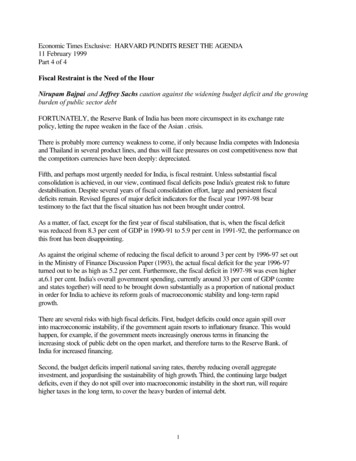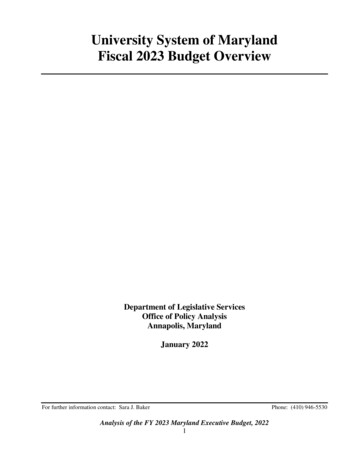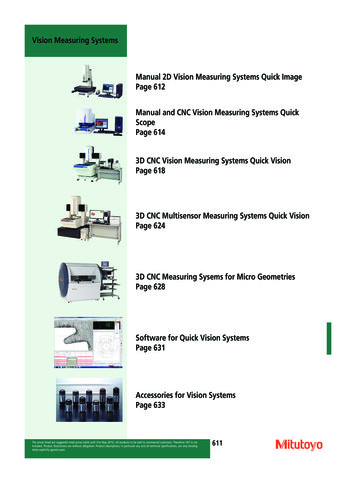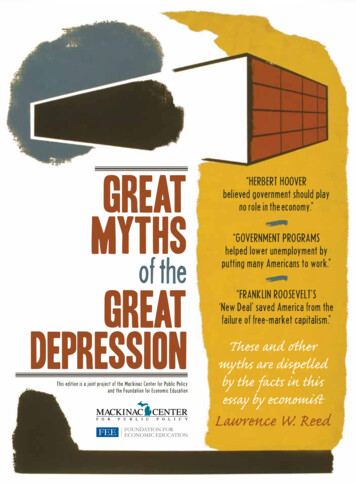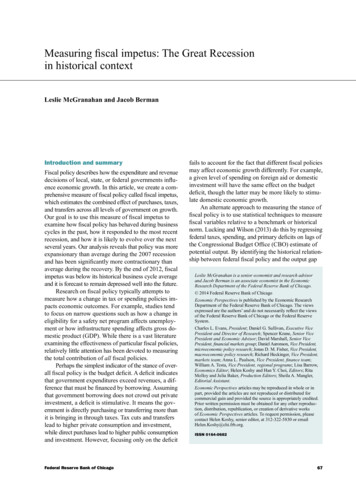
Transcription
Measuring fiscal impetus: The Great Recessionin historical contextLeslie McGranahan and Jacob BermanIntroduction and summaryFiscal policy describes how the expenditure and revenuedecisions of local, state, or federal governments influence economic growth. In this article, we create a comprehensive measure of fiscal policy called fiscal impetus,which estimates the combined effect of purchases, taxes,and transfers across all levels of government on growth.Our goal is to use this measure of fiscal impetus toexamine how fiscal policy has behaved during businesscycles in the past, how it responded to the most recentrecession, and how it is likely to evolve over the nextseveral years. Our analysis reveals that policy was moreexpansionary than average during the 2007 recessionand has been significantly more contractionary thanaverage during the recovery. By the end of 2012, fiscalimpetus was below its historical business cycle averageand it is forecast to remain depressed well into the future.Research on fiscal policy typically attempts tomeasure how a change in tax or spending policies impacts economic outcomes. For example, studies tendto focus on narrow questions such as how a change ineligibility for a safety net program affects unemployment or how infrastructure spending affects gross domestic product (GDP). While there is a vast literatureexamining the effectiveness of particular fiscal policies,relatively little attention has been devoted to measuringthe total contribution of all fiscal policies.Perhaps the simplest indicator of the stance of overall fiscal policy is the budget deficit. A deficit indicatesthat government expenditures exceed revenues, a difference that must be financed by borrowing. Assumingthat government borrowing does not crowd out privateinvestment, a deficit is stimulative. It means the government is directly purchasing or transferring more thanit is bringing in through taxes. Tax cuts and transferslead to higher private consumption and investment,while direct purchases lead to higher public consumptionand investment. However, focusing only on the deficitFederal Reserve Bank of Chicagofails to account for the fact that different fiscal policiesmay affect economic growth differently. For example,a given level of spending on foreign aid or domesticinvestment will have the same effect on the budgetdeficit, though the latter may be more likely to stimulate domestic economic growth.An alternate approach to measuring the stance offiscal policy is to use statistical techniques to measurefiscal variables relative to a benchmark or historicalnorm. Lucking and Wilson (2013) do this by regressingfederal taxes, spending, and primary deficits on lags ofthe Congressional Budget Office (CBO) estimate ofpotential output. By identifying the historical relationship between federal fiscal policy and the output gapLeslie McGranahan is a senior economist and research advisorand Jacob Berman is an associate economist in the EconomicResearch Department of the Federal Reserve Bank of Chicago. 2014 Federal Reserve Bank of ChicagoEconomic Perspectives is published by the Economic ResearchDepartment of the Federal Reserve Bank of Chicago. The viewsexpressed are the authors’ and do not necessarily reflect the viewsof the Federal Reserve Bank of Chicago or the Federal ReserveSystem.Charles L. Evans, President; Daniel G. Sullivan, Executive VicePresident and Director of Research; Spencer Krane, Senior VicePresident and Economic Advisor; David Marshall, Senior VicePresident, financial markets group; Daniel Aaronson, Vice President,microeconomic policy research; Jonas D. M. Fisher, Vice President,macroeconomic policy research; Richard Heckinger, Vice President,markets team; Anna L. Paulson, Vice President, finance team;William A. Testa, Vice President, regional programs; Lisa Barrow,Economics Editor; Helen Koshy and Han Y. Choi, Editors; RitaMolloy and Julia Baker, Production Editors; Sheila A. Mangler,Editorial Assistant.Economic Perspectives articles may be reproduced in whole or inpart, provided the articles are not reproduced or distributed forcommercial gain and provided the source is appropriately credited.Prior written permission must be obtained for any other reproduction, distribution, republication, or creation of derivative worksof Economic Perspectives articles. To request permission, pleasecontact Helen Koshy, senior editor, at 312-322-5830 or emailHelen.Koshy@chi.frb.org.ISSN 0164-068267
(the difference between potential and current output),they create a baseline against which recent policy canbe compared. They argue that federal fiscal policy hasbeen a modest drag on economic growth during therecovery from the Great Recession—because fiscalvariables have been less expansionary than would beexpected based on the magnitude of the output gap—and that it will continue to be a modest drag.Many research organizations, such as the International Monetary Fund (Bornhorst et al., 2011) and theCBO (2013a) have divided fiscal policy into structuraland temporary/cyclical components. The temporarycomponents aim to measure changes that are directresponses to the business cycle; they can also includethe effects of changing asset prices or temporary budgetitems. Any automatic stabilizers triggered by the taxcode or benefit systems are counted as cyclical, whilediscretionary fiscal policy is counted as structural. Otherauthors have relied on large-scale econometric modelsto estimate the effects of policies. These models lookat historical data and try to find statistical relationshipsbetween changes in fiscal variables and changes inoutput. For example, Follette and Lutz (2010) applyfiscal multipliers to a variety of policy factors andestimate their aggregate effects using the FRB/USmodel developed by staff of the Board of Governorsof the Federal Reserve System.In this exercise, we refrain from measuring thestance of fiscal policy using econometric techniques andinstead focus on developing a simple method to measure fiscal impetus that allows us to compare historicaldata from the National Income and Product Accounts(NIPAs), produced by the U.S. Bureau of EconomicAnalysis (BEA), across time in a meaningful and consistent way. Our approach has several strengths. First,it is comprehensive. Since our method only requiresdata from the national accounts, it can easily includeall sectors of government. While federal fiscal policyattracts significant attention, state and local policy isoften ignored. State and local governments accountfor 45 percent of all government receipts, and nearly40 percent of expenditures, so it is necessary to includethese sectors in any measure of overall fiscal stance.The national accounts data are also extremely detailed,making it easy to identify the sources of strength andweakness within subcategories. For example, withinthe national defense consumption expenditures category,we can see exactly how much ammunition purchasescontributed to fiscal impetus.Second, our method does not require us to disentangle structural policy changes (active policy changessuch as new direct spending) from automatic stabilizersand other cyclical changes (passive changes caused68by the business cycle). Although this distinction is useful for other types of analysis, classifying the source ofimpetus as active or passive should have no relationship to a measure of its scale.1 Additionally, separatingthe two forms of impetus can be challenging and imperfect (Weidner and Williams, 2014). Absent a measureof the output gap, we are not saying anything about thelevel of fiscal impetus relative to the decline or recoveryof economic activity. Instead, our goal is simply toreport what happened. Because our measure does notrequire a complex model, it can be easily updatedand modified.Our exercise makes assumptions about how fiscal policies affect contemporaneous output, but wemake no attempt to test those assumptions. Specifically, we will use multipliers estimated by the CBO toweight the impact of different types of policy. Rigorouslymeasuring these multipliers requires either a statisticalargument that identifies some exogenous policy variationor a dynamic equilibrium model that can account forthe various channels through which fiscal policy islikely to affect the economy. For example, more formalmodels can account for how a shock in governmentspending is likely to affect interest rates, inflation,productivity, incentives to work, or expectations offuture taxes. Instead of referring to this large (and oftencontroversial) literature, we take the CBO multipliersas given and ask what they imply about the stance offiscal policy more broadly.Detailed measurementIn this section, we develop the measure of fiscalimpetus that we use throughout the remainder of thearticle. Our goal is to have a measure of fiscal impetusthat is the sum of fiscal impetus arising from differentsources (taxes and transfers, federal and state) that isconceptually similar to the concept of the contributionsto real GDP percentage change as measured in the NIPAs(table 1.1.2) with the modification that we adjust forpopulation growth.2Let nominal output at time t be denoted by yt , andlet xi,t be the nominal value of a particular componentof fiscal policy indexed by i at time t. The percentcontribution is approximated as the percent changein a component of fiscal policy multiplied by its ratioto total output in the previous period, t–1. This is expressed as:1) xi ,t 1 xi ,t 1 . yt 1 xi ,t 1 To get the contribution in real per capita terms,we divide all nominal terms by an appropriate pricedeflator, pt , and the population, nt . Finally, we sum3Q/2014, Economic Perspectives
across each form of impetus to get the following measureof total fiscal impetus:2) ixi ,t 1 xi ,t pt 1nt 1 1 . yt 1 xi ,t 1 pt nt Note that when we set xi,t to government purchasesand assume no population growth, the measure is nearlyidentical to the BEA’s official calculation of the government contribution to percent change in real GDP published in NIPA table 1.1.2.3 We do not include any lagsin our equation, so we are measuring impetus as a shareof contemporaneous GDP. The effects on actual growthmay be more drawn out.DataOur three impetus categories are purchases, taxes,and transfer payments at both the federal and stateand local levels. Our purchases category includes allpurchases of goods and services included in government consumption expenditures and gross investmentin the NIPAs. Since governments produce nonmarketservices, the BEA uses the cost of inputs to impute themarket value of government production. At the federallevel, defense-related activities account for nearly twothirds of all purchases; the major nondefense categoriesinclude health research, health care services providedto veterans, tax collection and financial management,federal policing activities, and the administration ofsocial insurance programs. On the state and local level,the single largest category is primary and secondaryeducation; others include highway construction,police and fire services, higher education, and community services.Our second category of fiscal impetus is tax revenues. Tax revenues enter our measure of fiscal impetusnegatively because higher taxes reduce consumption.Our data come from NIPA table 3.1 and are personalcurrent taxes (the income tax and the capital gains tax),taxes on production and imports (property, sales, andexcise taxes), and contributions for government socialinsurance (employer and employee contributions toSocial Security, Medicare, and unemployment insurancetrust funds). During periods of economic slack, labortax revenue falls automatically as households have lesstaxable income and shift into brackets with lowermarginal tax rates. Additionally, in an effort to raisedisposable income and stimulate private demand,governments often respond to downturns by cuttingstatutory rates or expanding credits and deductions.Though property and sales taxes are less sensitive tobusiness cycles, revenue collections also tend to slowwhen the economy is depressed.Federal Reserve Bank of ChicagoThe final type of impetus in our model is transferpayments as recorded in NIPA table 3.12U. As withtaxes, changes in the level of transfers happen automatically as incomes fall or through policy changesthat expand eligibility. Transfer payments stimulateprivate demand by making more resources availableto households for consumption. Transfers can be eithercash payments, such as Social Security benefits, orin-kind transfers such as food stamps—an importantdistinction between the two is that in-kind benefitscannot be saved.To convert values into real terms, we use therelevant NIPA implicit price deflator. For taxes andtransfers, we use the personal consumption deflator;and for government purchases, we use the government consumption expenditures and gross investmentdeflator. Our population sample is the total populationof the United States as reported in NIPA table 2.1. Allgrowth rates are in real per capita, seasonally adjusted,annualized terms.Understanding fiscal impetusFigure 1 plots our measure of total fiscal impetusand the annual change in the total government deficit toGDP ratio. These are not measured in per capita terms.Although these two measures both come from theNIPAs, they are computed using different data andmethods. The cash deficit includes categories such asinterest payments and income receipts on assets thatwe do not include in our measure of fiscal impetussince their impact on economic activity is ambiguous.The mathematics behind both calculations are alsodifferent: The blue line in the figure represents a growthrate, while the red line is the difference between tworatios. Nevertheless, they tell broadly the same story.Years in which the deficit/GDP ratio is growing arealso years when fiscal impetus is expansionary.A problem with this unweighted fiscal impetusmeasure is that it fails to account for the fact thatdifferent forms of fiscal impetus may have differenteffects on economic activity. This is one of the reasonswe do not rely on the deficit as our impetus measure.To account for this, we apply weights or “multipliers,”denoted as wi , to different sources of fiscal impetus beforewe aggregate across the types. For example, if we wouldexpect a tax cut for a low-income household to be morelikely to be spent than a tax cut for a high-incomehousehold, we would assign a higher weight to lowincome tax cuts (as measured by cuts in the payrolltax). Our final impetus equation, then, is expressed as:3) wiixi ,t 1 xi ,t pt 1nt 1 1 . yt 1 xi ,t 1 pt nt 69
FIGURE 1FIGURE 2Comparing impetus and the budget deficitThe impact of weighting on impetuspercent6percent442200 2 41960’70’80’902000’10Unweighted impetusChange in deficit/GDPSources: U.S. Bureau of Economic Analysis accessed viaHaver Analytics and authors’ calculations.We assign a multiplier of 1.5 to purchases, 1.25to transfers, 0.8 to payroll taxes, and 0.4 to income,property, and sales taxes. We choose these weightsbased on research by the Congressional Budget Office.4As a simple robustness check, we perform all of ourcalculations using a multiplier of one for all forms ofimpetus in the appendix. In general, changes to themultipliers change the magnitude of impetus, but notits overall shape over time. To show the effect ofweighting, figure 2 compares impetus without population adjustment calculated using uniform weightsversus our preferred weights. Our preferred weightsincrease the mean of impetus over time, but decreaseits variance. Figure 3 shows annual fiscal impetussince 1960 using our preferred multipliers in real percapita growth terms.Fiscal impetus during the recessionWe developed this measure of fiscal impetus toanalyze fiscal policy during business cycles. Throughout, we use the National Bureau of Economic Research’sbusiness cycle dates to mark the beginning and end ofrecessions. To better understand the dynamics of fiscalpolicy during the 2007–09 recession, we compare thepath of key variables for the eight quarters followingthe 2007 peak with their path following other businesscycle peaks since 1960. Our sample of recessions includes the recessions starting in 1960, 1969, 1973, 1981,1990, and 2001. We start in 1960 since this avoids theseveral short recessions in the 1950s, as well as the70 21960’70’80’902000’10Unweighted impetusWeighted impetusSources: U.S. Bureau of Economic Analysis accessed viaHaver Analytics and authors’ calculations.large distortionary effects of the Korean War. We dropthe first part of the double-dip recession starting inJanuary of 1980. This approach provides a frameworkfor understanding how fiscal measures responded to therecession as it was happening. The eight-quarter periodcovers the beginning of the recession in the fourthquarter of 2007 through the fourth quarter of 2009.Figure 4 compares fiscal policy during the GreatRecession to the average fiscal policy in our historicalsample. We show the cumulative impetus as of eachquarter relative to the peak quarter. That is, we compound each quarter’s impetus to show the sum of allimpetus since the start of a recession. The faint linesin the background of the figure represent each previousrecession. Figure 5 shows cumulative impetus decomposed into its component parts. The thick black linerepresents the path of impetus during the average recession; any shaded area above the black line is policyimpetus since 2007 that was in excess of the historicalaverage, and any area below the line is policy impetusbelow the historical average. The black line, plus thedistance above it, minus the distance below, yields the2007 experience. A larger area represents a larger deviation from average. For example, in figure 5, the factthat the green region is above the black line in the laterquarters but its area is relatively small indicates thatthe growth in purchases during this recession was onlyslightly above average.5At quarter 8, the red line in figure 4 is above allof the faint lines, which indicates that fiscal policy3Q/2014, Economic Perspectives
FIGURE 3FIGURE 4Weighted fiscal impetusFiscal impetus during recessionsreal per capita GDP impulse4cumulative contribution to growth62402 219600’70’80’902000’100Sources: U.S. Bureau of Economic Analysis accessed viaHaver Analytics and authors’ calculations.24quarters since peakHistorical average68Great RecessionSources: U.S. Bureau of Economic Analysis accessed viaHaver Analytics and authors’ calculations.during the Great Recession was more expansionarythan in any previous post-1960 episode. The first majorsource of fiscal impetus came from the EconomicStimulus Act of 2008, which spent 113 billion onlump-sum, refundable tax rebates for individuals makingless than 75,000 and joint filers making less than 150,000. The NIPAs record this partially as an offsetto personal current taxes and partially as a currenttransfer payment. The spike due to this is clearly visibleas expansionary tax and transfer policy in the secondquarter of 2008 (the second quarter after the peak).Policy contracted in the following quarter as taxes andtransfers returned to their previous levels and then surgedback up as automatic stabilizers kicked in and Congresspassed the American Recovery and Reinvestment Act(ARRA). By the eighth quarter after the peak, impetuswas solidly above the previous historical high achievedduring the 1973 recession.As indicated in figure 5, the majority of excessstimulus came from falling taxes and increasing transfers;purchases account for only 10 percent of stimulus abovethe historical average. On the tax side, a sharp drop ineffective tax rates and ARRA-related tax cuts drovepersonal taxes well below historical levels. Payroll andproduction taxes were also below average, although thesize of the effect was modest. On the transfer side,stimulus was more evenly distributed across programs.A large portion of excess stimulus came from unemployment insurance with other categories includingrefundable tax credits, special payments to SocialSecurity beneficiaries, and increased food stamp benefits (Supplemental Nutrition Assistance Program, orFederal Reserve Bank of ChicagoFIGURE 5Excess impetus during recessionsby categorycumulative contribution to growth6420024quarters since peakPurchasesTransfers68TaxesSources: U.S. Bureau of Economic Analysis accessed viaHaver Analytics and authors’ calculations.SNAP). Medicaid transfers did not rise above the historical average. In the purchases category, nearly theentire excess stimulus came from defense purchases.Nondefense purchases were only slightly above average, and state and local government purchases were asignificant drag.71
FIGURE 6FIGURE 7Average fiscal impetus during recoveriesExcess impetus during recoveries by categorycumulative contribution to growthcumulative contribution to growth42200 2 2 4 4 6051015quarters since troughHistorical average20Great RecessionSources: U.S. Bureau of Economic Analysis accessed viaHaver Analytics and authors’ calculations.Fiscal impetus during the recoveryIn this section, we repeat the calculations above, butinstead plot the relevant series starting at the businesscycle trough and covering the subsequent 18 quarters.This approach allows us to study the dynamics of policyduring the recovery. The period covers the beginningof the recovery in the second quarter of 2009 all theway through the fourth quarter of 2013. As indicated infigure 6, fiscal policy during the recovery was significantly more contractionary than the historical average.The net effect of policy in the quarters immediatelyafter the beginning of the recovery hovered around zeroas opposed to the historical average, which is slightlypositive. Policy began contracting around the fifth quarterand remained near the low end of our comparison recoveries throughout most of the recovery. In the lastseveral quarters in the figure (representing late 2012and 2013) it fell precipitously, and by the end of 2013it was well below the previous historical low of the1969 recovery.Figure 7 divides the impetus contribution into itscomponent parts and shows that the tightening of fiscalpolicy was driven primarily by a decline in direct government purchases. While purchases grew at a slightlyabove-average rate during the recession, they shrankin almost every quarter of the recovery. Purchasesalso grew slowly during the recoveries of 1991 and1975, but by 2012 the cumulative decline was largerthan in any prior historical period. The decline in purchases was driven mostly by cuts by state and local72051015quarters since troughPurchasesTransfers20TaxesSources: U.S. Bureau of Economic Analysis accessed viaHaver Analytics and authors’ calculations.governments. Figure 8 highlights that the contraction instate and local government purchases far exceeded thatof any previous historical episode. The contribution offederal government purchases was also below average,though the magnitude of the effect was less dramatic.In the nondefense sector, the federal civilian work forcedeclined to the smallest level since 1966 and intermediate purchases also fell considerably. However, giventhat nondefense purchases are not a large part of thegovernment sector, this was only a modest drag. Thecumulative effect of defense purchases hovered near zeroand then slowly drifted down around 2011—a trendroughly in line with the historical average. Overall,about 70 percent of the relative decline in purchasesis explained by the state and local sector.Despite persistently high unemployment, transferpayments in this recovery grew below the historical average. Per capita spending on Social Security, Medicare,and Medicaid—which together account for three-quartersof all government social benefits—was below average.This is consistent with the record-low growth in national health expenditures over the past several years.Unemployment insurance was a relative drag, but itwas declining from unusually high levels. Spendingon SNAP benefits was consistently higher than average;however, even at its peak, SNAP accounted for only3 percent of social benefits, so the magnitude of theeffect was small.The relative drag from purchases and transfersduring the recovery was partially offset by tax policy.3Q/2014, Economic Perspectives
FIGURE 8FIGURE 9State and local purchases during the recoveryAverage fiscal impetus over business cyclescumulative contribution to growthcumulative contribution to growth36241200 1 2 2051015quarters since troughHistorical average20Great RecessionSources: U.S. Bureau of Economic Analysis accessed viaHaver Analytics and authors’ calculations.The net effect of tax policy throughout most of therecovery was near zero, compared with the negativehistorical average, which indicates that taxes usuallyincrease. The 2001 recovery was the only one in whichtax policy was a larger contribution to growth than in2009. Almost the entire tax stimulus came from thepayroll tax cut of 2011, which cut the rate for employeecontributions from 6.2 percent to 4.2 percent. WhenCongress allowed this legislation to expire in 2013,payroll revenues rose sharply and by the end of 2013,tax policy had converged back to its historical average.Personal current taxes (as opposed to payroll taxes)were a relative drag throughout the recovery, whileproduction taxes made a modest positive contribution.A sharp increase in taxes combined with decliningpurchases made the first quarter of 2013 (quarter 14 infigure 6) the most contractionary quarter of fiscal policysince 1960. Under our specification of the weights,the magnitude of drag in that quarter was 4 percentof per capita GDP.Fiscal impetus over the full business cycleIn this section, we repeat the calculations abovefor the entire business cycle. This allows us to comparethe size of the fiscal expansion during the recessionwith the fiscal contraction during the recovery. Weare interested in assessing the extent to which theunprecedented decline during the recovery offset theincrease during the recession. We start in the fourthquarter of 2007 and continue through the fourth quarterFederal Reserve Bank of Chicago051015quarters since peakHistorical average2025Great RecessionSources: U.S. Bureau of Economic Analysis accessed viaHaver Analytics and authors’ calculations.of 2013. Figure 9 shows that relative to the historicalbaseline, although fiscal policy was unusually expansionary during the recession, the contraction in fiscalpolicy following the recession was even larger. Thecumulative contribution to growth of fiscal policywas more stimulative than average up until the middle of 2012 when the red line crosses the blue line.By the end of 2013, cumulative fiscal impetus wassolidly below its historical average.Figure 10 presents this information in a differentway. We show the data as growth rates for each quarterwithout cumulating over time. In past business cycles,policy started as moderately expansionary, shifted toneutral or slightly negative, and then returned to amodest positive contribution about 15 quarters after thebusiness cycle peak. During the most recent episode,policy started as strongly expansionary, contractedsignificantly, eased somewhat, and then contractedagain. In table 1, we report summary statistics for fiscalpolicy following each peak over the quarters whenreal per capita GDP was below its pre-recession level.This represents the business cycle period before theeconomy has returned to trend growth. As a result, thenumber of quarters differs for each recession. Changingthe number of quarters under consideration for a particular business cycle will tend to change the magnitudeof the averages, but the general trends are consistentacross most sample periods. Overall, we find that fiscalpolicy was less expansionary and more volatile thanaverage following the 2007 peak. Within our sample,73
FIGURE 10Contemporaneous fiscal impulseHistorical averagereal per capita growth impulseGreat Recessionreal per capita growth impulse10105500 5 5051015quarters since peak2025051015quarters since peak2025Sources: U.S. Bureau of Economic Analysis accessed via Haver Analytics and authors’ calculations.TABLE 1Average fiscal impetus over recession and recoveryPurchasesStart of recession196019691973198119902001Average (1960–2001)2007Taxes1.03– 1.120.660.58– 0.111.050.37– 0.28– 0.060.310.180.100.070.17– 0.250.04the 2007 business cycle had the smallest average impetusand the highest standard deviation. Figure 11 confirmsthis graphically; namely that the source of weaknesswas largely in the purchases category, which subtractedan average 0.28 percent from growth instead of adding0.37 percent as it typically has. Low purchases werepartially offset by expansionary tax policy and slightlyabove-average transfers. Within purchases, the stateand local government sector explains nearly the entiredecline; national defense was modestly above average,and nondefense was roughly average.Fiscal impetus from ARRA and payroll tax cutAs mentioned earlier, fiscal policy changes areoften divided into discretionary policy and automaticstabilizers. In this section, we discuss some of the74TransfersTotal fiscal impetusMeanMeanMeanMeanStandard deviation( - - - - - - - - - - - - - - - - - - - - - - - - - - - - - - - - - - percent - - - - - - - - - - - - - - - - - - - - - - - - - - - - - - - - - - - gest discretionary changes. Government on the local,state, and federal level responded to the Great Recessionwith a variety of discretionary fiscal policies. A fullcataloging of these policies is beyond the scope ofthis article, but there are two large federal programsthat merit special attention: the American Recoveryand Reinvestment Act (ARRA) passed in 2009 andthe payroll tax holiday passed in 2011. In sup
Leslie McGranahan and Jacob Berman Introduction and summary Fiscal policy describes how the expenditure and revenue decisions of local, state, or federal governments influ-ence economic growth. In this article, we create a com-prehensive measure of fiscal policy called fiscal impetus, which estimates the combined effect of purchases, taxes,




